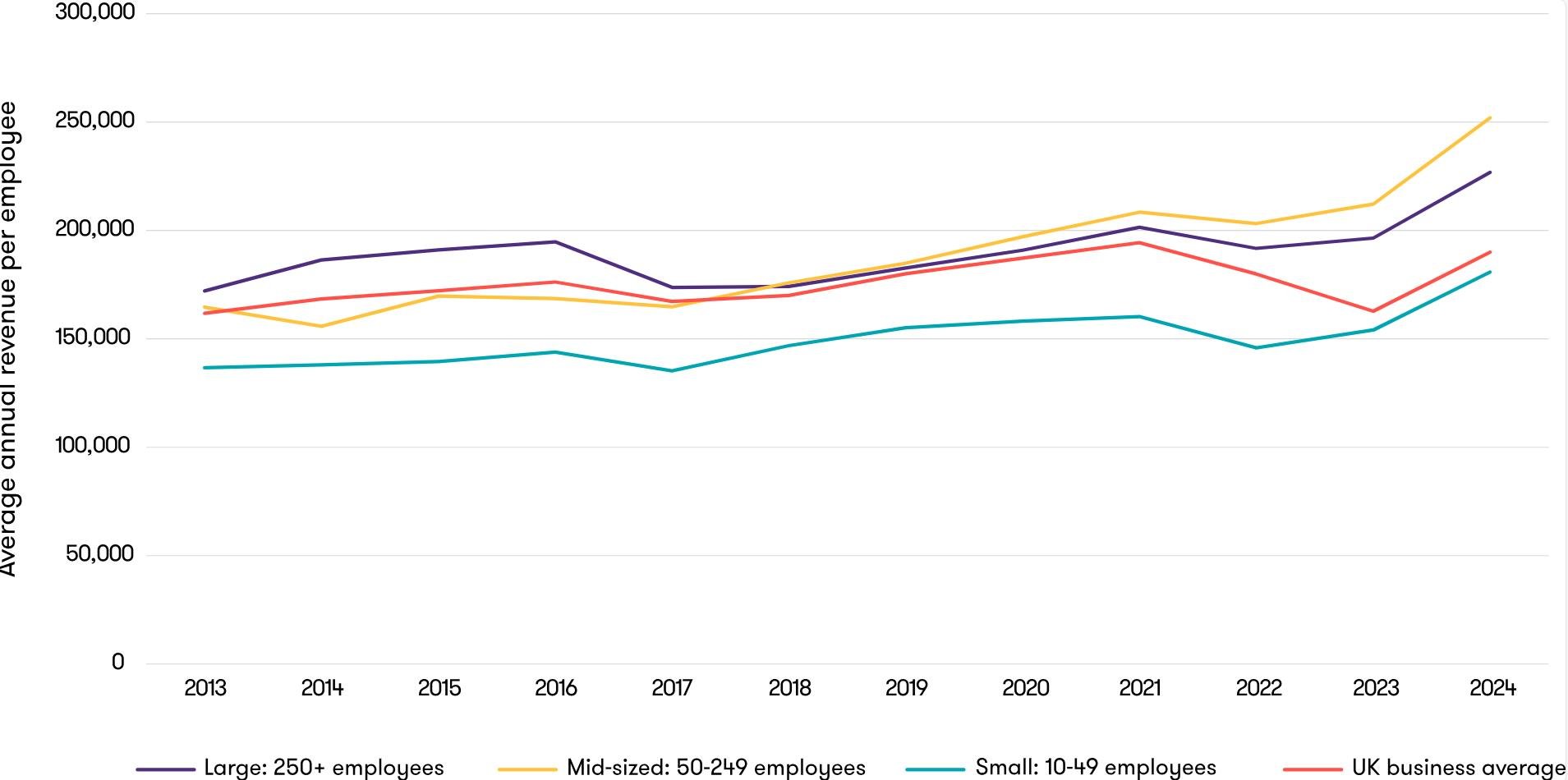Analysis from Grant Thornton UK finds that labour productivity of UK mid-size businesses, when measured as average annual revenue per employee, has surpassed that of larger and smaller companies, and the UK average, for the past seven years.
Compiled in advance of the Autumn Budget 2025, the research, which analyses labour productivity levels of UK businesses over the past eleven years*, finds that, in 2024, the productivity gap by company size continued to widen, with mid-size businesses (MSBs) pulling further ahead than other segments. This trajectory has continued since 2018 when MSBs started to outshine both larger and smaller businesses.
In 2024, average annual revenue per employee was 11% higher at MSBs than at larger companies (up 4% since 2023) and 15% higher than the UK average for businesses with 10+ employees** (up 3% since 2023).
Graph showing UK company productivy by size
Though the mid-market continues to lead the way, productivity in UK business remains low by international standards, and according to ONS data, in Q2 2025 UK productivity was 0.8% lower than in Q2 2024.
Grant Thornton's Business Outlook Tracker research, which regularly surveys a panel of 600 mid-market business decision makers*** showed strong confidence from the mid-market about their own growth, funding and the outlook for the UK economy, demonstrating a resilience and appetite for growth and improved productivity.
However, businesses are also feeling pressure from rising costs, labour market shifts, and ongoing uncertainty. This was evidenced by a dramatic dip in profit expectations (-21pp) compared to June 2025, now at the lowest level recorded by the Tracker since December 2021.
Despite these challenges, and the uncertainty about further tax pressures as we head towards the 2025 Autumn Budget – over three quarters (78%) of mid-market leaders believe the UK Government’s Industrial Strategy will help improve national productivity levels. This indicates optimism about policy direction, despite broader economic uncertainty.
Skills shortages are a major barrier to improved productivity
In terms of the factors influencing productivity, 79% of respondents said a lack of necessary skills is affecting their productivity- which aligns with concerns about training and recruitment and highlights the need for targeted upskilling initiatives.
Of those who say lack of skills is affecting productivity, the following skills are cited as the top three most important to deliver improved productivity:
- Leadership skills (19%) – although 72% already have internal training in place
- Skills for managing remote teams (18%) - 79% already have internal training in place
- Communication skills (18%) – 73% already have internal training in place
AI seen as key enabler for productivity
AI was seen by the survey respondents as a powerful driver of productivity, with 78% of mid-market businesses expecting AI to deliver a positive impact on productivity within the next 12 months.
81% said they are exploring AI to enhance—not replace—employee output, signalling a clear shift toward augmentative technology that supports human effort rather than substitutes it.
Yet, this momentum is tempered by caution. 24% of businesses cited uncertainty around AI regulation and ethical use as a key barrier to productivity. As AI adoption scales, so does the imperative to address risks around transparency, fairness, and compliance. Responsible deployment—grounded in clear governance and ethical frameworks—will be essential to sustaining trust and long-term value.
Carolyn Hicks, Transformation and People Advisory Partner at Grant Thornton UK, said:
“Mid-market businesses continue to set the pace for UK productivity, but the challenge of skills shortages is ever-present. In my work supporting clients through transformation and people change, I see first-hand how targeted upskilling and a focus on leadership and communication are critical to unlocking growth.
“Why the mid-market is so resilient is a salient question. Essentially, it's down to their size, enabling them with greater agility than their larger competitors. They also tend to have better access to resources and capital than smaller competitors, giving them greater opportunity to weather change and invest in the future. These factors generally mean that mid-size businesses are more resilient to shocks and market uncertainty. Their success also stems from the beneficial blend of an entrepreneurial mindset of a smaller business with the resources of a larger one.
“This mix of agility and financial resources plays out particularly when it comes to technology adoption. The emergence of AI as a productivity enabler for example is a game-changer—when deployed responsibly, it augments human capability and empowers teams to achieve more. With talent shortages posing a challenge to growth, AI is stepping in as a productivity partner, enhancing what people can achieve.
“Our clients, small, medium and large are increasingly exploring AI not to replace people, but to enhance their impact, and I believe that a balanced approach to technology and talent will be key to sustaining long-term success. The mid-market is well placed to capitalise on the opportunities that AI brings.”
ENDS
Notes to editors:
* Looking at private companies only, with 10+ employees. Labour productivity measured by average annual revenue per worker, using annual Government Business Population Estimates and business size definitions:
Small: 10-49 employees
Medium: 50-249 employees
Large: 250+ employees
** UK average of private companies with 10+ employees
*** Survey conducted by Censuswide, on behalf of Grant Thornton UK, of 600 senior decision makers in UK mid-sized businesses in September 2024. Mid-sized business defined as those with annual revenue between £50million-£500million.

